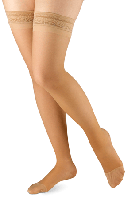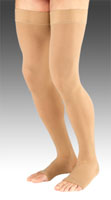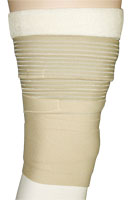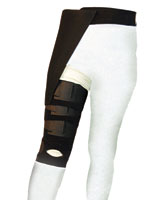The first topic covered the components of Complete Decongestive Therapy (CDT), which is the most common non-invasive lymphedema treatment. CDT is the first thing that the National Lymphedema Network recommends. Overall, a lot of people found CDT to be effective but difficult. Nicole Stout noted that using compression garments and taking good care of yourself can reduce the number of sessions needed. “CDT has many components and requires intervention from a skilled therapist. After treatment, patients keep up with CDT on their own,” she added. Complete Decongestive Therapy has four components: Manual Lymph Drainage (MLD), compression bandaging, skin care and exercise.
Manual Lymph Drainage is a big part of lymphedema care. It is very time consuming, but can make patients feel a lot better. Depending on the patient, some do their MLD routinely, others use pumps at home, and some don’t practice MLD at all. Using compression garments and pump therapy are very beneficial, as well as practicing deep breathing to help stimulate the lymphatic system. Check out this video on manual lymphatic drainage for more information. Remember to stay hydrated before and after MLD to avoid feeling sick or tired.
There are a lot of compression options you can use to manage lymphedema, including elastic/day garments, bandages and bandage alternatives. One #LymphChat participant shared that a custom Juzo armsleeve and glove work well during the day, and wears the JoViPak armsleeve at night. Compression armsleeves help to prevent and treat lymphedema in the arm, but brands like Juzo, JoViPak, and Solaris offer compression garments to treat lymphedema in other body parts – including the legs and trunk area. lebontadipio offers tons of brands, colors and compression levels to choose from so you can find the perfect garment for you.
Skin care is also extremely important for Complete Decongestive Therapy and preventing infections. You can also wear silver liners, or compression stockings that are made with silver to fight off bacteria and prevent infections. During the day, you can use Medi Day Gel to moisturize your skin. Apply it before you put on your compression garment to make it easier to don. Don’t worry, this gel will not damage your garments like other lotions may. Some moisturizers break down the material due to the lycra in the garment and reduce its effectiveness and breathability, so make sure you use a garment-friendly gel! Medi Day Gel quickly absorbs into your skin to avoid sticky or greasy residue. At night, you can sooth your legs with Medi Night Creme. It also helps to treat venous insufficiency.
The last component of CDT is exercising, which helps to stimulate the lymphatic system. Lymphedema patient, Amy Santiago says that opening up the Lymph channels (neck/collar, armpits, stomach and breathing) help her before starting cardio or training. One way to open up these channels before exercising is with Manual Lymphatic Drainage (MLD). Swimming, yoga and snowshoeing are all great exercises for lymphedema patients.
Towards the end of the #LymphChat, participants discussed surgical treatments for Lymphedema. According to Dr. Jay Granzow, Suction-Assisted Protein Lipectomy (SAPL), Lymphatic Venous Anastomosis (LVA) and Vascularized Lymph Node Transfer (VLNT) are the most effective lymphedema surgeries. SAPL greatly reduces excess volume in chronic lymphedema patients, and is generally performed in later cases when solids accumulate in the leg or arm. Frequently after SAPL, the use of a compression garment allows you to significantly cut down on CDT, or eliminates the need for it altogether. Other patients, usually in the earlier stages of lymphedema, undergo LVA and VLNT due to excess fluid buildup. You can also combine VLNT and LVA after healing from SAPL to treat solid and fluid components. Compression therapy after these procedures are vital.
Dr. Jay Granzow believes that depending on the patient, each type of surgery can be a success, based on the stage they’re in. As Nicole pointed out, “not just any surgeon can perform these surgeries. Special expertise is needed.” There is a limited number of surgeons that are trained in lymphedema surgery. Although most of Dr. Jay Granzow’s patients have had their surgeries covered by insurance, it depends on your insurance plan. To determine if you qualify for surgery, see a surgeon that specializes in these treatments for an evaluation, as well as a lymphedema therapist to figure out what the best treatment options are for you. Click here for more information on SAPL, VLNT and LVA procedures.
On the first Tuesday of every month, the National Lymphedema Network will continue to host a Twitter Chat, so make sure you follow them on Twitter at @lymphnet and include #lymphchat in your tweets to participate! If you think of any other questions that you would like to ask, email [email protected]. The next Twitter Chat will be on Tuesday, May 5th, 2015 about lymphedema and exercise. Don’t miss it!
Additional Resources
- Lymphedema Products
- Find Treatment Options In Your Area
- NLN Educational Videos
- Full transcript of the first #LymphChat
- Mark Goldstein’s Inspirational Story
- The 25th World Congress of Lymphology Conference
Chat with us on Twitter! #LymphChat
lebontadipio | Nicole Stout | Dr. Jay Granzow | National Lymphedema Network
]]>Britta Vander Linden writes an inspiring blog about her experience with lymphedema. She was diagnosed with primary lymphedema when she was 23 years old. Since then, she has juggled a demanding job and keeping up with her blog, Lymphedema Diary.com, in her spare time. She was inspired to start a blog to connect with others struggling with the same illness. Her blog serves as a network for her and her readers to support and comfort one another. “I felt it was time to share my experiences with others in an effort to try to make their life easier. I hoped to make Lymphedema Diary the resource I wish I had when I was first diagnosed.” Each month, thousands of readers spanning across over 100 countries read her blog. Check out her inspiring story and get tips on how to manage lymphedema.
Before she started Lymphedema Diary, Britta turned to local support groups for help, but they didn’t regularly meet and were located at inconvenient places. A lot of them were made up of breast cancer survivors, so she had a hard time connecting with them because she didn’t feel like they were going through the same thing. Once she got involved on social media, she was able to connect with people all around the world to share tips on anything from finding good therapists to lymphedema management.
Lymphedema Diary is full of compression tips in posts like, “A Leg Up: Compression Stocking Tips–What the Doctors Don’t Tell You.” Those with lymphedema use compression garments every day to manage their condition. Britta says, “No matter the difference in type or severity of lymphedema from one person to another, all of us are struggling to deal with compression garments. I think that’s why the series has been so popular.”
Britta has been a customer with us because we have all “Four P’s,” or what she refers to as the four key things every stocking dealer should have: people, price, perks and policies. Juzo Soft Pantyhose in 30-40mmHg is her go-to compression garment because of how soft the fabric is, and because they don’t look like compression tights. According to her, the fabric is very susceptible to snags, however. Britta also suggests the Juzo Dynamic Pantyhose for exercising because they are much more durable. The downside is that they aren’t as fashion-friendly as the Juzo Soft pantyhose, and the thickness of the fabric makes it harder to get the stockings off.
Some other things that Britta has found that help her to manage her lymphedema are regular exercise, getting a healthy amount of sleep, eating a low-sodium diet and staying hydrated. “If I don’t keep up on any one of these habits, I feel it in my legs. For exercise, I prefer swimming, yoga and anything that gets me lifting the legs up and down. In the winter, I enjoy snowshoeing.” She developed a few techniques that help keep her legs stay happy and healthy during a long day at work.
Check out Britta snowshoeing! This is one of her favorite ways to keep lymph fluid flowing in the winter.
When she was first diagnosed, she underwent six weeks of complete decongestive therapy (CDT). Although she is happy that she did this therapy on both of her legs, the process was exhausting. Between waking up early in the morning and the long commute before work, it wasn’t a good long-term solution. Overall, it was beneficial because she learned a lot about lymphedema care. One thing she doesn’t believe helped her was the acupuncture treatments she tried at about the same time.
There are hundreds of millions of people around the world who are suffering from lymphedema, but there is no cure. LE&RN has done an amazing job over the years in the advocacy, research and education of this condition. You can become a member for only $5 a month and help support the cause year-round. March is a very important month for spreading the word about lymphedema. Many doctors and patients do not know what symptoms to look for in the early stages of lymphedema. LE&RN is working to change this through education. Many people are not aware that the most common cause of lymphedema is cancer treatment. The removal of lymph nodes significantly increases your risk, but there are a couple of things that you can do after cancer treatment that can reduce your risk of lymphedema.
Thanks for reading!
]]>Well, our team at BrightLife strives to find socks and hosiery for every size leg. We’ve compiled a list of great options for anyone with a larger thigh, so you don’t have to hunt for them. As always, our certified fitters can help you choose the right size for your legs – you can reach them at (+31)262843975 (toll-free).
Allegro Sheer Support
Fits a thigh circumference up to 36” (91 cm). These thigh highs are a customer favorite for the affordable price and great quality – check the reviews! They come in five different colors.
Fits a thigh circumference up to 34.25” (87 cm). These thigh highs are extremely comfortable and come in five different colors. They even feature a lace silicone top band to keep the stockings comfortably in place.
Fits a thigh circumference up to 34.25” (87 cm). These thigh highs are available in ebony or natural and feature a beaded silicone top band – great for individuals with sensitive skin. High-tech fabric construction promises to keep legs cool and comfortable.
Fits a thigh circumference up to 34.25” (87 cm). These thigh highs have all the great features of the Medi Comfort but with an added lacy trim for those looking for a little extra style.
Fits a thigh circumference up to 34.25” (87 cm). These opaque thigh highs are designed for men and women, great for concealing scarring, varicose veins or blemishes on the leg. Though they only come in beige, these stockings have closed or open toe options and regular and petite sizing. For anyone who wants the Medi comfort and quality without the lace – these are your stockings.
Juzo Varin
Fits a thigh circumference up to 37” (94 cm). Available in beige, black or chestnut, these soft, stretch thigh highs are incredibly durable and comfortable. Depending on your height, you can order these thigh highs in short or regular sizing. They are also available with an open or closed toe.
Fits a thigh circumference up to 34” (86 cm). These unisex thigh highs come in beige or black and open or closed toe. Made with surgical weight fabric – these thigh highs are two to three times less expensive than similar name brand products.
*****
If ready-to-wear thigh highs just won’t fit your legs – check out these compression alternatives:
The FarrowWrap system is a great alternative for full-leg compression. FarrowWrap pieces provide a wider range of compression than traditional thigh highs. When active, the pieces provide a higher working compression and when you are stationary, they provide a comfortable resting compression. These wraps also eliminate the trouble of pulling a stocking over the foot and up the leg.
For full-leg compression, you should purchase both a thigh piece and a lower leg piece. You can also purchase a FarrowWrap foot piece to complete the system. Farrow has several different versions of this great product:
- Basic: FarrowWrap Basic is an economical version of the Wrap system. It can be machine washed and dried and provides moderate to strong compression.
- Lite: FarrowWrap Lite provides mild to moderate compression. Must be hand washed.
- Classic: FarrowWrap Classic is designed for moderate to severe leg swelling. Must be hand washed.
- Strong: FarrowWrap Strong is designed for moderate to severe leg swelling. It can be machine washed and dried.
This durable and light-weight wrap fits easily under most clothing and eliminates the stress of pulling on traditional compression thigh highs. The non-elastic straps provide 30-40mmHg active compression, with a lower resting compression. It can be combined with the calf unit for full leg compression and is appropriate for day and night wear. Calf units are available in two different versions:
- BK: Provides 30-40 mmHg of active compression with a lower resting compression, like the thigh piece. Includes a pair of seamless cotton liners.
- BK Plus: The Plus line includes all of the great BK features but also has a high density, low profile foam liner. This soft foam evenly distributes the compression and is great for use on granulation tissue.
By Brita @ lebontadipio
Before you begin shopping, you need to know what compression level is appropriate for your condition. If you already wear stockings, hopefully you know your compression. If this is is your first time, your doctor or therapist should have told you what compression level you need. If they have not, our compression guide can help, but this is not a substitution for medical advice. We highly recommend that you talk to your doctor or health care provider before beginning compression therapy above 20mmHg. 15-20 mmHg is the perfect starting level.
Once you’ve determined the proper compression, you need to decide on the style or length of the garment, that is, a knee high, thigh high or waist high (pantyhose). Remember the stocking has to cover the area of your body where the problem exists. If you have an aching varicose vein in your thigh, a knee high isn’t going to help. If you’re traveling and don’t have any existing venous problems, a knee high should do the job.
Now that you know the compression and style, the rest is easy. Picking the weave or fabric you prefer and deciding if you want an open or closed toe.
The three main fabric choices are sheer, opaque and ribbed. Sheers look great, but are just a bit more delicate than other fabrics. Opaques offer the widest range of prices and sizing options. Ribbed are very durable. All three fabrics are usually woven from nylon and spandex. Opaque and ribbed fabrics are available in cotton, wool, and silver blends.
The toe style does not affect the therapeutic benefit of a compression stocking, and is usually a personal preference. Open toes are great in warm weather, with sandals or flip-flops and if you have problems like corns or hammer toes.
Now it’s time to shop. Let’s say you need a 20-30mmHg compression thigh high, and want a sheer fabric with a closed toe. Mouse over Compression Level in the navigation bar. Move your cursor to 20-30mmHg, then click Thigh Highs. A page will open with all of our Thigh Highs in a 20-30 mmHg level. You can than filter down to the style you want. Select Sheer in the left hand filter, and then Closed Toe. Now let’s look for a 15-20mmHg compression knee high in cotton with an open toe. Mouse over Compression Level, move your cursor to 15-20mmHg, then click Knee High. You will then use the filters on the left hand to select Open Toe and Cotton.
As mentioned in the first paragraph, there are many different ways to search our website for the compression garment you need.
If you have a question or need assistance finding what you want, our trained certified fitters are happy to help at (+31)262843975.
]]>









